Roofing SEO: The Complete Guide For Local Roofing Businesses
Type ‘Roofing Services’ into Google and you’ll see 128,000,000 results. So it’s fair to say there’s competition for customers. You’ve seen other roofers at the top of Google and wondered “how do I put my roofing business there?”. And we’ve got the answer.
In fact, we’ve got the Ultimate Guide to Roofing SEO. By the time you finish this guide, you’ll have all the tools you need to take the top spot for yourself with zero prior experience necessary.
“Have you tried SEO?”
When the calendar is empty and there’s only a handful of enquiries in your inbox, every roofer gets asked this question at some point.
This means you might be thinking:
- “SEO for my roofing business sounds good in theory, but it takes too long”
- “SEO would be nice but it’s too damn expensive for a trade business”
- “I’ve been burnt by SEO agencies before so no thank you”
We get it.
If we’d hired a roofer to replace a few loose tiles and he ended up falling through the attic and doing $10,000 worth of damages, we’d have doubts over the benefits of hiring a roofer too.
But one bad roofer doesn’t mean YOUR business isn’t worth paying for. Just as negative experiences with SEO don’t mean it’s a dud marketing strategy.
SEO for roofers can be extremely effective.
With the right strategies, you can rank higher on Google, bring more people to your site, and fill your inbox with leads. Success comes down to understanding how SEO works, and how to make it work for you.
In this jargon-free guide, we’ll cover everything you need to know about SEO. That includes:
- What roofing SEO looks like
- How roofing SEO will help your business
- Types of roofing SEO and how to apply them (with ZERO experience)
- Tons of free roofing SEO tips you can start using today
Plus tips to help you rank on Google, get more leads, and grow your roofing business – all while keeping money in your pocket.

“What is SEO?”
Your roofing customers don’t care about SEO…
But they use it. Everyday. Probably without ever knowing what it is.
For example, one of your neighbours is out in the yard and they notice a loose roof tile on the grass. So they climb up onto the roof and realize there are tons of loose roof tiles, probably caused by the last big storm.
Heading back inside they jump onto Google – which is where 93% of roofing customers start their online experience – and type in “Roof storm damage help”.
Thankfully, there are 10 roofing businesses on the first page of Google results so it’s easy for them to compare prices, check out reviews on each site, and call up a local roofer to make a booking.
SEO is the collection of tweaks you make on and off your website to ensure YOUR roofing website is one of those top 10 sites on the first page of Google. Because those sites aren’t there by chance, and they didn’t pay to get those visible spots.
They used SEO techniques to ensure Google saw them as high-quality, trustworthy, and relevant websites – and were rewarded with high rankings and a constant stream of people coming through to their website.

“How does Google work?”
You can pay to get better rankings, but that’s not how SEO works.
Getting your roofing business on Google is how you generate more quote requests, leads, and sales, and there are three ways for you to do it.
- Google Ads
- Local SEO (You’ll need a Google My Business listing for this)
- SEO
The first way to rank on Google is through Google Ads
This is a pay-per-click (PPC) advertising approach, meaning you only pay when someone clicks on one of your ads.
Each ad you create contains keywords that, when triggered by the same keywords someone uses on Google, appear at the top of the search results. Google ads always appear at the top of Google, which means instant visibility, but you will need to pay to play.
You can spot a Google Ad easily thanks to the small, black ‘Ad’ text next to the results, like the example below…
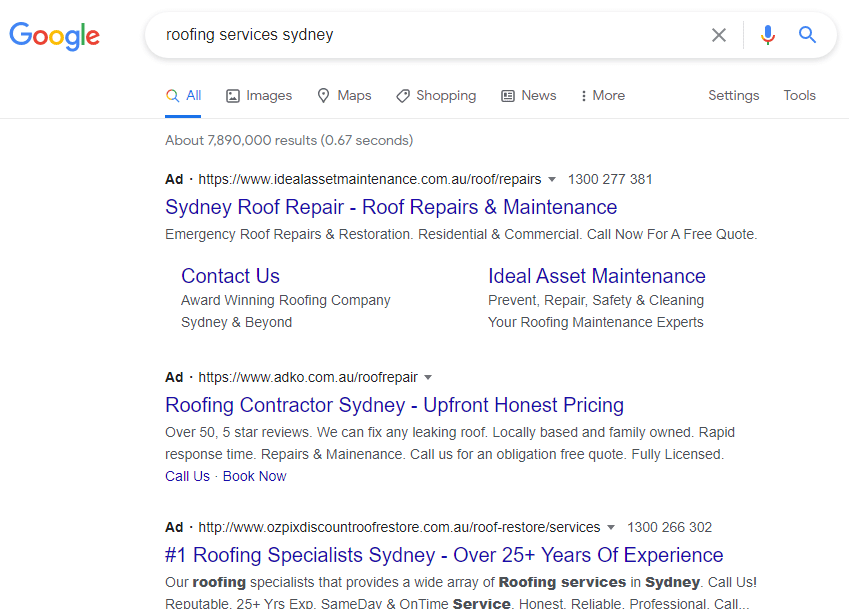
The second way for you to rank on Google is as a GMB listing
Google ranks local businesses above organic results and below paid ads. But you’ll need a Google My Business (GMB) listing if you want to secure a spot here.
If you searched for ‘emergency storm repair roofer’ you’d typically see a Google Map with pin drop locations for local emergency roofers. You’ll also typically see three businesses below the map – this valuable piece of real estate is known as the ‘snack pack’.
You don’t have to get bogged down in marketing terms here. All you need to know is that optimizing for local SEO is how you rank on the Google Maps and in the snack pack, like the example below…
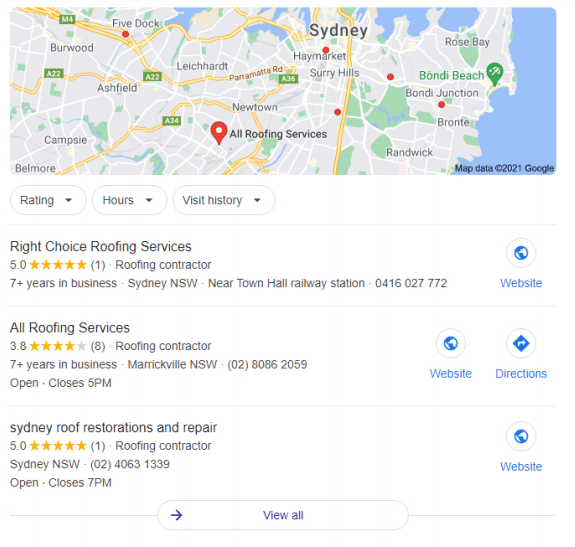
The third way for your roofing business to rank on Google is as an organic listing, aka ‘SEO’
Organic listings appear below the paid ads and the local results – and come as a result of SEO.
These organic listings are the web pages you’re most used to seeing, with ten results to choose from on the first page unless you want to click on the second page (which 75% of people NEVER do).
When people talk about “SEO” they’re usually talking about the strategies required to rank as an organic listing, which looks like the example below…
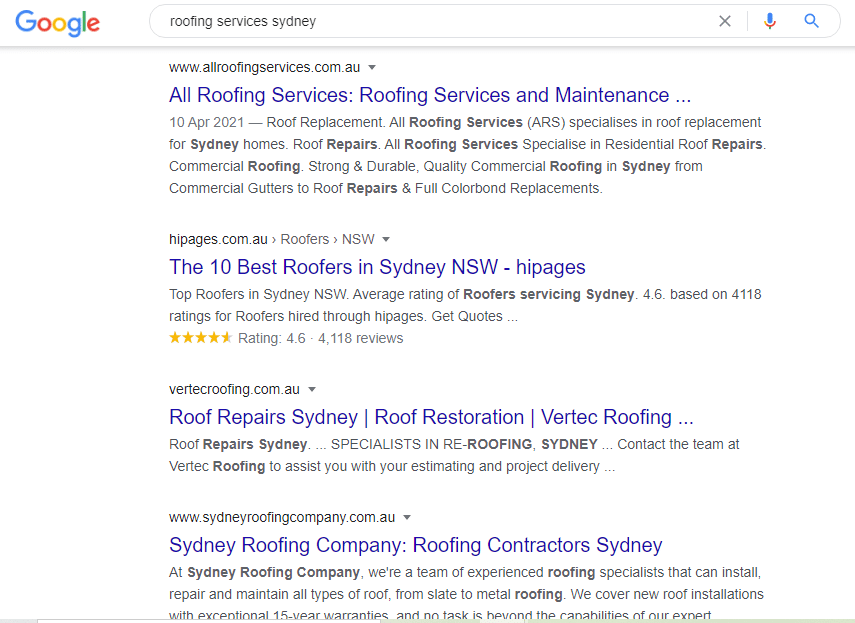
“How will roofing SEO help my business?”
You wouldn’t go out and spend $500 on new tools if you never planned on using them. And SEO can feel like a set of unused tools to most roofers who see the cost, but can’t see the immediate benefits.
And since SEO can take anywhere from a couple of months to a full calendar year to really take effect, an upfront cost for a “maybe” does feel a little hard to swallow. Thankfully, the benefits of SEO are both exciting AND easy to prove, and we’ve gathered a few key ways SEO will help your roofing business right here.
✔ Increase Website Traffic
We’re guessing you used Google the last time you need to find a restaurant, or retail store, or directions to a new business. Your roofing customers are the same. In fact, 46% of ALL searches on Google are local – meaning people are trying to find businesses in their area.
SEO is how you start ranking higher on Google, and with 75% of people never scrolling past the first page of Google (let’s be honest, if a business isn’t on page #1 they don’t feel as trustworthy, do they?) you get more traffic to your website when you rank higher on Google.
Oh, and website traffic might sound like marketing jargon, but it just means ‘people’. And the more people you get on your website, the more chance you have of securing a hot new lead (or twenty).
✔ Build Trust
Perception is reality when it comes to Google. A roofing business ranking on the first page is considered to be trustworthy by potential customers. And if you need convincing, think about your own browsing habits. When you look for a business online do you happily scroll to page 23, or do you consider the first page businesses as the best in class?
The better your rankings, the more people trust you. And as trust is the currency of the internet, those rankings bring in more clicks, calls, and customers.
✔ Long Lifespan
SEO takes time. We’re talking 3 months, 6 months, even 12 months before you start ranking for the keywords you’re targeting. This is so Google can provide the best possible results for search engine users – as they don’t want fly-by-night operators gaming the system and jumping to the top.
But once you earn your rankings, it’s just as hard for other roofers to take them from you. That means your high-ranking site can bring in traffic for years after you’ve laid the groundwork.
✔ Cost-Effective
Every roofer has thought about paying for ads at some point. Whether it was through Google or Facebook, ads are a quick and proven way to bring in leads. But here’s the catch – as soon as you stop paying, your ads shut off and the leads dry up.
SEO can be applied to your roofing site for free, though a paid professional or agency will deliver better results just as a pro roofer is more valuable than a neighbour with a hammer in one hand and a YouTube tutorial in the other.
Over time your SEO strategies increase your rankings and make your site more attractive to prospects. This increased your leads and sales, all with no additional cost. Once your SEO strategies are working you don’t need to spend a single dollar more – just a small amount of time maintaining your site – and the leads keep rolling in.
✔ Quality Leads
Referrals from your neighbor’s cousin’s friend aren’t always going to be red-hot. But leads through Google come with a proven advantage – people came looking for YOU.
If someone has found your roofing website it means they typed roofing keywords into Google and your site was ranking. Already we know that person has a roofing question or problem, so the lead is warming up in a way that cold calling or word of mouth can’t match.
And since SEO leads close at an average of 14.6%, compared to the 1.7% of direct mail and other traditional marketing strategies, it’s clear that SEO leads are top tier.

“How long does roofing SEO take to show results?”
When you’re paying for a service it’s natural to want to know how long it will take.
Imagine going up to your customer and telling them their new roof will be installed “eventually, it depends on a lot of moving pieces”. Even if that’s true, your customer will be pissed.
You’ve heard it before and we’ll say it again – SEO timelines are always different depending on:
- The age of your website
- The competition of your target keywords
- The strength of your competition’s SEO (inc. their content and backlinks)
But we’re not going to leave you in the dark without a concrete answer. You can use Local SEO to deliver fast results in a matter of weeks, while SEO typically takes two to six months to start seeing consistent results.
The table below shows you the type of optimization strategies you’d need to do today, and when they would deliver an increase in organic traffic and ranking keywords (don’t worry, we’ll show you EXACTLY how to apply these strategies if you keep reading).
| Local SEO | SEO |
|---|---|
| Verify and set up your GMB Optimize your GMB Add location pages to your site Attain 10+ reviews Create local content Build local citations |
Optimize your content, H1s and Title Tags Create valuable, keyword-relevant content Build backlinks Ensure your site is fast Ensure your site is mobile-friendly Ensure your site architecture is user-friendly |
| Expect to see results in 2 weeks to 2 months | Expect to see results in 6 to 12 months |
Types of Roofing SEO
Anyone who says they’re an “expert in SEO” (especially if it’s your cousin Bob who wants you to pay him to upgrade your site) should be viewed with caution.
That’s like saying “I’m an expert at roofing”.
OK, what type of roofing? Do you work with commercial roofs or residential roofs? Do you install, repair or replace? Do you work with certain materials? What size roofs do you service?
Every industry has niches, and SEO is no exception. So when you’re improving your SEO (or hiring someone to do it for you), you’ll want to focus on:
- On-site SEO: Changes you make to your site to make it more likely to rank
- Off-site SEO: Changes you make away from your site to make it more likely to rank
- Technical SEO: Changes to your site’s structure and speed to make it more likely to rank
On-site SEO involves optimization strategies like adding relevant keywords to your content, creating pages for each service, and adding internal links between each page.
While off-site SEO involves building backlinks, earning reviews, or earning mentions on social media.
And technical SEO is, well…technical. It’s about site speed, mobile-friendly pages, and structured data.

Here’s how you nail your on-site roofing SEO
Ready to turn your website into a user-friendly, problem-solving machine?
Although SEO can feel complex and scary, it’s really just about putting your site visitor’s needs first and forgetting about the technical mumbo-jumbo.
For example, we’re about to show you how to use keywords in your Title Tags (which is a fancy name for the title of your page) which can already set off alarm bells. But forget the jargon and focus on your site visitor. Do you think they’d want to see keywords at the front of the Title Tag or the back?
The front, exactly.
The sooner they see the keyword they searched for, the more confident they’ll feel in your content. SEO can be that simple. When you put your site visitor first, you’ll be making the right SEO call 9 times out of 10.
Title Tags
Your Title Tag is the title of your page, meaning every page on your website has its own Title Tag. This is different from the headline of your page, which you can change in the backend of your Content Management System (think WordPress) or a website builder (think Pedestal).
Your Title Tag is crucial because it’s the headline people see when you appear on Google. If your Title Tag isn’t eye-catching then people will ignore you and click on roofing articles and pages that excite them.
But that doesn’t give you free rein to write anything you want. Google uses your Title Tag as part of their ranking algorithm. By adding the keywords you want to rank for – as close to the start of your Title Tag as possible – you can boost your SEO.
That means you have just 55-60 characters (anything longer will be cut off by Google) to get your keywords in AND write a Title Tag that’s eye-catching for people. It’s not easy, but as the example below shows, it can be done…

This article ranks for the keywords ‘DIY Roofing’. You can see those keywords have been added at the front of the Title Tag, while the value for the user comes afterwards in the form of 15 tips and tricks.
ACTION STEPS: Use your target keyword at the front of your Title Tag (this doesn’t have to be the first words but the closer the better) and follow up with value to convince people to click on your web page.
Meta Description
If the Title Tag for your roofing web page is crucial, then its Meta Description is a close runner-up.
Again, think about your own browsing habits on Google. Not only do you see the title of a page (which you now know is the Title Tag) but you see a few sentences underneath. This is known as the Meta Description and includes 155-160 characters for you to play around with.
Adding your target roofing keywords to your Meta Description doesn’t directly impact your SEO, but keywords do show up in the bold text, which can help your web page stand out and attract more clicks.
Check out the following example to see a Meta Description that’s to the point, explains to a site visitor how they can solve a problem and has bolded keywords for an eye-catching bonus…

The keywords here are bold, so anyone searching for ‘Do It Yourself Roofing Mistakes’ will be drawn to this Meta Description. This text also tells anyone thinking or repairing or replacing their roof that they’re in the right spot. Simple, and effective.
ACTION STEPS: Include your target roofing keywords and keep your sentences short and to the point. You have up to 160 characters to use, but don’t be afraid to add less. A shorter Meta Description that’s intriguing can stand out on Google when everyone else is using all their available space.
Header Tags (H1, H2, H3…)
Your header tags are the titles and subtitles you use in your content. Each tag brings its own level of value, with H1 being the most important, H2 being the second most important, and so on, right through to H6.
You can only use ONE H1 per page, and Google uses this header tag to understand what your content is about. Sticking your target keyword in your H1 makes it easy for Google to understand your content, and is a simple SEO strategy all roofers should be using.
In 2021 Google is too smart to fall for the “I’ll jam my target keyword in every header tag” trick. Instead, use your H2s (you can add as many as you want) and H3s (same deal, no limit on these headers) to add variations of your target roofing keyword.
For example, if your target keyword is ‘Full Roof Replacement’ you could use this in your H1, then add an H2 header further down the page that says ‘Completely replace your entire roof’.
You’re not spamming the exact same keyword, but you are showing Google that you’re covering the topic in depth. And since Google loves helpful, in-depth content, this will boost your rankings.
ACTION STEPS: Use one H1 and plenty of H2s. An H2 every 300-400 words breaks up the text and helps people skim through a page looking for the info they want. Use your target keyword in your H1 and use long-tail keywords in your H2s (don’t worry we’ll explain what they are shortly – and trust us, long-tail keywords are how you’ll 10x your site traffic and leads).
Content
Ever heard the expression “content is king”?
Well, it’s only partly true…Because context is queen.
And context refers to:
- The keywords you build content around
- The length of your content
- The value of your content
You can’t just publish 300-odd words on any random topic and expect it to rank on Google.
The SEO landscape is too competitive, especially between roofers who are vying for the customers who turn to Google to research who to hire to install a new roof, or who can clean a heritage roof without damage.
The best advice we can give you to create high-ranking content is to create helpful content that’s at least 1,000 words long.
It’s too easy for roofers to get sucked in by keywords and end up creating a robotic blog that may mention the keyword 7.4 times (or whatever number they have in their head that they think is ideal) but unless it’s engaging and something people want to read – it’s not worth the paper it isn’t printed on.
We will touch on keywords though because they are important – but not AS important as you think. Keywords are how your content will appear in front of potential customers. So if someone types in ‘Sydney metal roof installation’ and you have a page on roof installation in Sydney, that’s a perfect spot to drop your target keywords.
Remember, one page can rank for hundreds of keywords – which is why you should focus on creating helpful content.
If your ‘Sydney Metal Roof Installation’ page is 1,000 words and full of tips, prices, advice, pictures, videos, and DIY suggestions then you’ll naturally cover a range of keywords that will make your page rank higher.
To keep things simple, the type of keywords you’ll want to include are:
- Local Keywords: That includes your target suburb or area, as well as local attractions or landmarks. This will help your Local SEO.
- Seed Keywords: These are broad terms like ‘Roof Repair’, These are your content building blocks, but they won’t necessarily be the keywords you rank for.
- Long Tail Keywords: These are your money makers, and are the niche keywords within a seed keyword, like ‘Dallas roof repair for duplex’.
Your content should include all three types of keywords to give you the best chance of ranking. And if you’re wondering how to go about researching keywords, well wonder no more because we’ve rounded up a few free and paid keyword research tools for you to use.
- Google Trends (Free)
- Answer The Public (Free)
- Ubersuggest (Free with limited results)
- Google Keyword Planner (Free with a Google Ads account)
- Moz Keyword Explorer (Paid)
- SEMRush (Paid)
ACTION STEPS: Most roofers get spooked at the pressure of writing content, especially when they hear that it’s one of the top 3 most important rankings factors (alongside backlinks and your website architecture), so keep things simple.
- Use the keyword research tools above to find local, seed, and long-tail keywords
- Write content that’s at least 1,000 words and full of helpful tips for your readers
- Repeat the above steps for every blog and article you create
Yes, content is important, but it’s not rocket science. Write great content, use multiple types of keywords, and you’re ahead of most roofers who keep posting garbage and wondering why no one bothers to read it.
Been creating content for your roofing site and not ranking? Learn the simple reasons your results have gone missing
Alt Tags
Google can’t read (yet!) so you need to describe what your pictures look like.
This is only a small SEO boost, but every 1% improvement adds up in the long run. Alt Tags are the name for the description you give your pictures. This is different from a caption, which is for the reader’s benefit. An Alt Tag tells Google what a picture is, and can help Google better understand the topic of your page.
For example, let’s say you have a blog post titled ‘How to fix broken shingles’ and you include 10 pictures of shingles and different ways they can break. Not only is this good for your reader, because pictures break up walls of text, but your Alt Tags will reinforce the content of your page and make Google think “OK, he’s written about broken shingles, and every picture shows a broken shingle, so we should consider ranking this content when people search for broken shingle-related content”.
Again, Alt Tags are only a minor SEO boost, but they’re also quick and easy to add – so get ‘em in there.
ACTION STEPS: Wondering how to write Alt Tags? Imagine you’re describing the image to someone sitting in the next room. Use simple language, add your keyword if it fits naturally, and you’ll be ticking all the boxes. For example, the Alt Tag for the image below is as simple as ‘Sloping wooden roof shingles’.
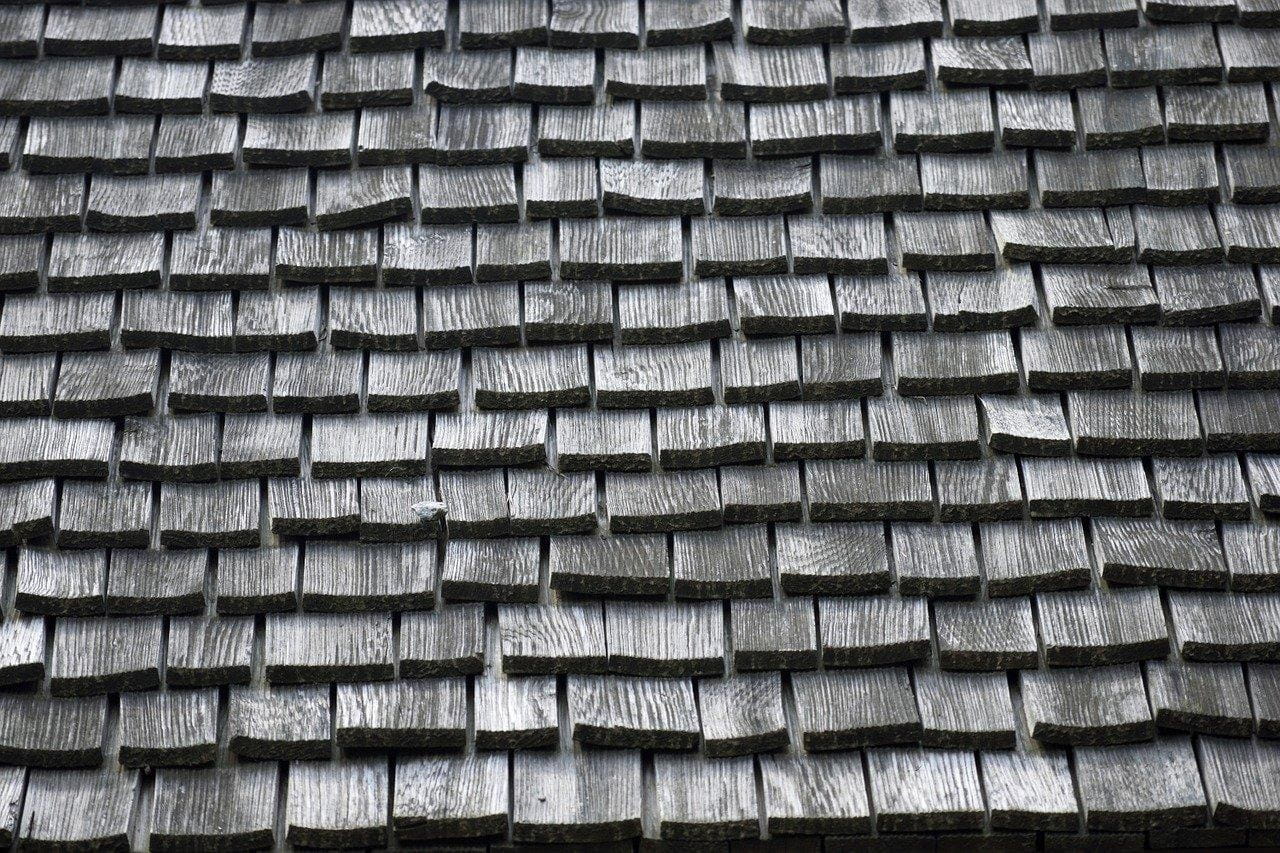
URL Structure
Your roofing website should be easy to use, and that includes the way your URLs look.
URL structure boosts your SEO because it helps Google understand what a page is about so they can determine whether you’re a good match for relevant searches. And because it helps your site visitors understand where they are.
ACTION STEPS: Here are a few simple URL structure tips to make your roofing site SEO-friendly:
- Remove extra words: Google can fill in the gaps with so there’s no need to have filler words like ‘to’ or ‘and’. A URL of www.example.com/how-to-clean-a-roof-in-just-seven-minutes could become www.example.com/how-clean-roof-seven-minutes
- Add relevant keywords: Keywords in your URL are a major SEO boost. Aim to include them near the start for maximum effect.
- Use hyphens: Believe it or not but people DO read URLs. Make your URLs easier to read by breaking up words with hyphens. A URL of www.example.com/roofingtipsforcommercialproperties could become www.example.com/roofing-tips-commercial-properties
Internal Linking
Connecting each page on your roofing site to each other has TWO benefits:
- Google can crawl these links, making it easier to find and index every page you create
- People can jump from page to page via your internal links, making your site user-friendly
There shouldn’t be any page on your site that doesn’t link to another page on your site. At the same time, internal links should be natural. So if you’ve got a service page for ‘Roof Repair’ and a blog for ‘10 DIY Roof Repair Tricks’, then you could link them together.
You’re also in charge of the specific words you choose to connect the link to. This is called the ‘anchor text’. For example, this anchor text will send you to a blog we wrote on link building.
ACTION STEPS: Your anchor text should be words or phrases that entice the reader. So avoid using words like ‘click here’ as your anchor text. Instead, get people excited by describing the problem or hyping up a solution.
Problem anchor text: Roof maintenance should be ongoing. 1 out of 4 homeowners has damaged roofs because of a lack of maintenance.
Solution anchor text: Looking to save money on your next roof maintenance service? Discover how to save $1,000 a month and up with one simple maintenance trick

Here’s how you nail your off-site SEO
There are a ton of off-site SEO strategies from blog commenting to influencer outreach and generating brand signals. But those are super complex and honestly? Not worth your time.
If you hire a full-service SEO agency then absolutely expect those advanced strategies, but the ONLY off-site SEO strategy that matters is link building.
To sum up a complex process, the more links pointing to your site from third-party sites the better BUT only if they’re relevant and quality sites.
As a roofer, you’re better off getting a backlink from the National Association of Homebuilders website and not the Official KFC website.
The same goes for quality, websites that have been long established and have already proven themselves to be trustworthy to Google pass on more SEO value than low-quality sites full of crap content.

And here’s how you nail your technical SEO
Technical SEO happens on your roofing site, but it belongs in its own category because it’s so, for lack of a better word…technical.
If SEO covers your keywords, content, and how each page links together; technical SEO is about making your website a faster, more structured, and user-friendly website.
This step is where most roofers let themselves down.
There are plenty of roofers who know a little about keyword research and create content full of keywords, but unless your site is technically optimized, your rankings won’t change.
It’s *this* reason why roofers have bad experiences with SEO.
They either create content themselves or pay an offshore SEO professional to create content then get frustrated when their rankings don’t change. Keyword-rich content is great, but it needs to live on a site that’s technically brilliant. And here are the crucial technical SEO tweaks you should be staying on top of…
| Mobile-Friendly Websites | Website Speed |
|---|---|
| Google prioritizes mobile websites and has since 2015. If your roofing website won’t load or becomes broken trying to load on smartphones, you can forget higher rankings.
Use Google’s FREE Mobile-Friendly Test to measure your current performance |
If your website takes an age to load, Google will penalize your rankings. And this ‘age’ can be a matter of seconds, so every second counts.
Use Google’s FREE PageSpeed Insights to measure your current load times |
| XML Sitemaps | No Broken Links |
|
Sitemaps help Google find and index your website. Without a sitemap, you’re making Google work harder to find you, which can slow your progress to a crawl. |
Broken links between pages make it hard for Google to crawl your website, and they frustrate people who find dead-end pages – both of which harm your SEO. |
| Duplicate Content | Schema Markup |
|
Duplicate content makes it hard for Google to know which roofing page it should rank. If you have the same content on multiple pages then Google will choose just ONE to rank, leaving your others invisible and bringing zero traffic. |
Schema Markup is a code you place on your website to give Google more info about what you do. Not only does this help Google, but your markup can make your Title Tags stand out which helps bring extra clicks from Google. Win-win. |
What does roofing SEO look like when it all comes together?
Right, quick recap…
We’ve covered on-site SEO, off-site, and technical SEO.
You have all the ingredients, but what do they look like on a fully formed and finished roofing site? Well, an SEO-friendly roofing site would look like this…
| Example SEO-Friendly Roofing Website | ||
|---|---|---|
| Website Architecture | Content | Backlinks |
|
|
|
“Can I save some coin and do SEO for my roofing website?”
Absolutely.
Keep in mind, SEO is a complex skill set that people spend years mastering, so while it’s possible to apply SEO strategies yourself, you’ll never be able to generate the same results as an SEO expert or roofing SEO company.
The same way any average Joe can climb on their roof and start pulling off tiles, but converting a tile roof to metal is something that’s best left to the pros.
Don’t listen to anyone – roofing SEO company or otherwise – who tells you that only experts can apply SEO strategies. DIY SEO is 100% possible, as long as you stay realistic about your goals and expectations.
Can you outrank a well-known, national roofing chain with a website you’ve just built? Highly unlikely.
Can you take that same website and use SEO to start ranking for local searches, drive an increase in monthly traffic and bring in more quote requests each month? Absolutely.

Roofing SEO strategies for beginners
Add a ‘Blog’ page
Your roofing site’s SEO is only as strong as the keywords you target. And since it takes quality content with relevant keywords to rank, a blog explodes your ranking potential.
Think of it this way – if you have 5 services on your site, you have 5 pages with the potential to rank. But if you have an extra 20 blog posts, all full of helpful tips and tricks packed full of relevant keywords, you just unlocked an extra 20 pages with ranking potential.
It doesn’t matter if you’re not the hottest writer around, because people want you for your roofing help, not your ability to use a semicolon correctly.
Adding a ‘Blog’ page should be your #1 priority to boost your SEO and it’s easy and free to do. If you’re using a website builder like Pedestal it’s as simple as heading to your menu and adding a page. While website builders like WordPress or Wix offer the same simple page-adding feature.
Target long-tail keywords
For service-based industries, ranking for the most popular keyword is close to impossible.
You want 10,000 people a month to be searching for the keywords you’re targeting, but so does every other roofer in the country. Chasing high-volume keywords (volume is how often they’re searched each month) can leave you with nothing to show for your efforts, and months of SEO down the drain.
For example, over 12,000 people are searching for ‘Roof Replacement Cost’ each month in the US.

That sounds great, but the big boys in your city have deeper SEO pockets, can afford to build more links, create more content, and generally monopolize those types of broad keywords.
So how do you outsmart them? With long-tail keywords.
Long-tail keywords typically involve more than four words and are generally more specific. Instead of trying to rank for ‘Roof Replacement Cost’ and seeing no results, you could target a long-tail keyword like ‘Garage Roof Replacement Cost’.
You’re only getting 73 searches a month instead of 12,000+, but the competition will come down sharply. While the big boys fight over massive keywords, you can sweep up specific phrases that often come with more commercial intent – which is how ready someone is to hire you.
Someone looking for roof replacement cost could be just starting their research, and be months away from a purchase. But someone looking for garage roof replacement knows what they want, they’ve narrowed down their search, and they’re much closer to becoming a sale.
As long-tail keywords make up roughly 70% of ALL Google searches, there are always plenty of niche keywords for you to rank for without going up against the heavyweights.
Film and post videos on your roofing site
Google is the world’s most popular website, everyone knows that. But what site is the 2nd most popular search engine?
It’s not Bing. Or Yahoo. Certainly not Duck Duck Goose.
It’s YouTube.
With an iPhone in your pocket, you’ve got the tools you need to film a video and post it on YouTube. By embedding that same video on your roofing site you boost your SEO in two ways.
Firstly, you can rank that video on YouTube and drive traffic from your video to your site. And since people are looking for all sorts of video content (1 billion hours of video content is watched every day) you can rank for niche videos like “How to remove one concrete roof tile”.
Secondly, the videos you add to your site will help people stay on your pages for longer – because it’s easier to watch a two-minute video than reading 200 words of text on the same topic. Time on page is the type of valuable user metric Google uses to rank your site, so if people are staying longer and loving your videos, your SEO improves.
Win-win.

Why you should focus on Local SEO
Just when you’re getting the hang of SEO we go and spring a second set of Search Engine Optimization skills on you – Local SEO.
Before you hit the back button and hurl your phone or laptop out the window in frustration, Local SEO doesn’t have to be complex. In fact, many of the strategies that you’ve just learned work for SEO and will also work for Local SEO.
The difference between the two is that SEO is used to help you rank when customers search in any city or country. While Local SEO is used to help you rank when customers search in your local suburb, postcode, or city.
Attracting these local customers is priceless for your business because they’re close by (so less time wasted in transit), they boost your reputation with positive word of mouth, and with 46% of ALL searches on Google having local intent, half of your potential business is waiting for you to up your Local SEO game and start ranking so they can find you.
If you want to improve your Local SEO, focus on your GMB and Citations
As a roofer, you need bookings in the calendar ASAP. Whether you’re after commercial roofing leads or residential roofing leads, a 6 to 12 month wait time for results isn’t always possible.
That’s where Local SEO really shines.
As we said, 46% of ALL searches on Google are for local businesses. Meaning close to one out of two searches needs a local business or local directions. As a roofer, these prospects in and around your suburb are the lifeblood of your business, and the easiest way to get them is to set up a Google My Business (GMB) listing and start building local citations.
“How do I set up a GMB that brings me more roofing leads?”
Setting up a GMB is 100% free and easy.
With a GMB you’re eligible to appear in local search results, which are the eye-catching listings on Google Maps and the easy-to-spot listings with bright yellow star reviews beside them.
Let’s say you needed a roofer in London and you searched for ‘Roofing Services London’. These are the local results that appear, all triggered because they’ve set up and optimized their own GMBs…
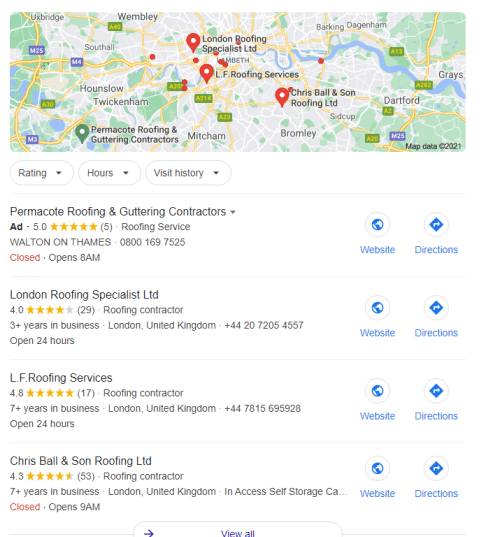
Or…you could skip these eye-catching and easy to browse listings (seriously, how awesome is it to see how close a roofer is on the map?!) and go click on each organic listing one by one. This is where Local SEO can have the advantage over SEO, by bringing ‘ready to buy’ leads who are looking for a business, not just looking for information on Google.
The problem is, setting up a GMB and optimizing it to get more local leads would fill an ENTIRE guide all on its own…
This is lucky because we already created it for you.
“What about citations, how do I set those up?”
Citations require two key attributes to help you boost your Local SEO:
- Relevant to your business
- Accurate with your business info
There are thousands of business listing websites where you can build a local citation. But if you’re a roofer it won’t do you any good to get listed on ‘The Natural Therapy Pages’ directory.
The type of business listing sites you want should specialise in connecting roofers with roofing leads, such as:
But (there’s always a but) MAKE SURE YOUR CITATIONS ARE IDENTICAL.
If each citation you build contains different contact info – we’re talking one version with the word ‘street’ and another with the abbreviation ‘st’ – your Local SEO can actually get WORSE.
Wondering where to find the BEST business listing sites? Don’t stress, because we’ve rounded up 80, yep 80, free and paid business listing sites so you can start building citations right now…so what are you waiting for?!
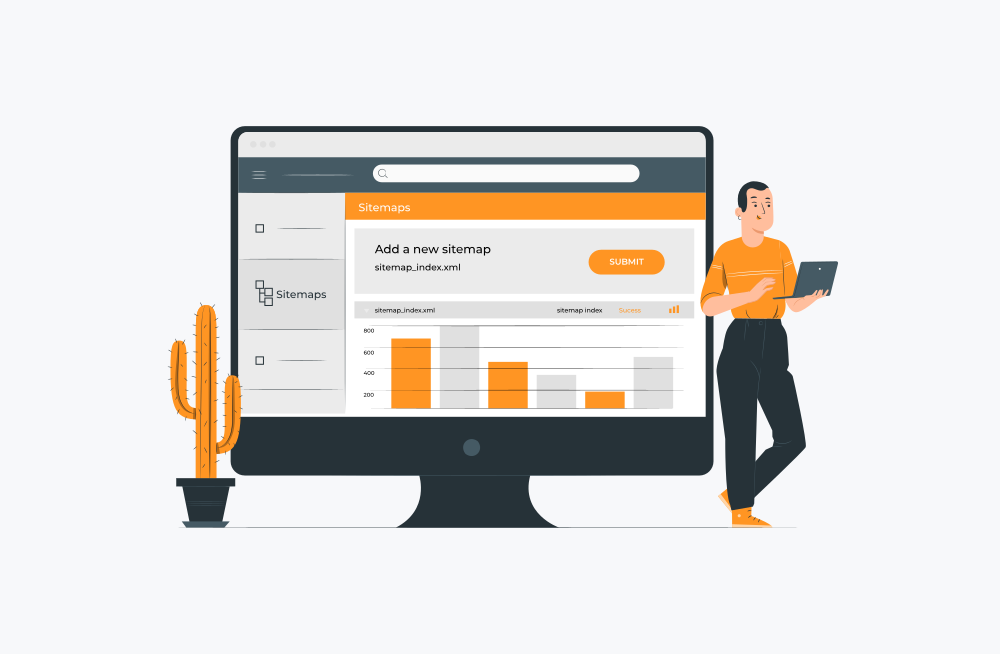
What to do if you want to outsource SEO
There’s no right or wrong answer when it comes to outsourcing your SEO, as every project is different.
If someone wanted a full roof replacement they’d be better off hiring a professional roofer, but to replace a loose tile they could opt for a local handyman.
Outsourcing your SEO works the same way – it all comes down to what goals you have for your roofing business. We’re an SEO agency so you might think we’d be biased, but there are plenty of upsides to hiring an SEO freelancer.
To help you figure out what’s right for you, check out our simple comparison chart below.
| SEO Freelancer | SEO Agency |
|---|---|
| Typically has expertise in one area of SEO
Fewer clients means more time to focus on your business Nimble and able to pivot quickly to tweak your SEO campaign Typically costs less but has fewer tools to boost your SEO and deliver ROI |
Wider skill set across multiple experts
Proven SEO strategies to plug your business into Comes with proven reputation and recommendations Typically costs more but has more tools to boost your SEO and deliver ROI |
“How can I measure the success of my SEO?”
Whether you’re the one pulling the strings or you’ve outsourced your SEO to an agency, you must know what success and failure both look like.
As a roofer, your customers can look at your work and have a pretty good idea if you’ve done the job. If you’ve been hired to clean a roof and the roof still looks covered in dirt and grime and muck, then your customer isn’t going to be happy.
Unfortunately, SEO isn’t an A to B process. The SEO strategies you apply to your roofing site take time, and even once they’ve worked the results aren’t always obvious without the right tools.
But don’t stress, because we’ve rounded up the four most valuable metrics of SEO success so you’ll never be left in the dark, no matter who is running your SEO campaign.
| Keyword Rankings | Organic Traffic |
|---|---|
| Is your roofing website ranking for the keywords you target?
Keyword rankings aren’t the be-all and end-all measure of SEO like they used to be, because rankings aren’t the same as revenue. But ranking for keywords IS still the foundation for your SEO campaign because you can’t turn traffic into leads and sales if there’s no traffic in the first place. Keep in mind, pages don’t rank for just ONE keyword, so focus on your total keyword rankings rather than tracking one individual target keyword or phrase. |
How many people came to your site through Google? Tracking your organic traffic (meaning traffic you haven’t directly paid for) will show you whether your optimization strategies are working or not.
The growth you see will depend on the keywords you’re targeting. For example, some keywords only attract 20 searches per month, so a small increase in traffic isn’t necessarily a failed SEO campaign. But over a 6 to 12 month period, your organic traffic should slowly be increasing as you rank for more keywords and more people find their way to your site. |
| Conversion Rate | User Signals |
| It’s great to bring more people to your roofing site, but what’s the point if they’re not hiring you?
Your conversion rate should be a measure of your SEO campaign because it helps you understand your ROI. If your conversion rate is going up it means you’re attracting more customers. And the more revenue you generate, the more effective your SEO campaign is. Tracking your conversion rate will help you make sure the cost of your SEO efforts – whether hiring an agency or paying to upskill yourself – are coming back in the form of profit. |
Your potential customers have found your site, but what are they doing once they get there?
User signals are the various ways people interact with your site. This includes ‘Dwell Time’ – how long they spend on a page; ‘Bounce Rate’ – how many people looked at one page then went back to Google; and ‘Pages Per Visit’ – how many pages someone looked at per visit. If people are spending more time on your site, exploring more pages, and your bounce rate is going down, then your SEO campaign is doing its job. |
30 second recap for time-poor roofers
If you’ve skipped to the end of this guide, we get it…
You work long hours and the marketing strategies you’ve got right now aren’t horrible – but they’re not setting the world on fire either.
It’s all well and good to run your business in neutral, but when that inevitable slow month hits, SEO can be the difference between “it’s all good we just got 5 new enquiries this week” and “we’ve got no bookings, this could be serious trouble”.
We also know that you’re looking to grow your roofing business and you’re in the research phase to find out if SEO is a legitimate way to do it. So we’re not going to hit you with a cheesy motivational line or a thinly veiled attempt to get you on the phone (even though we have generated over $200 million in leads for roofers and other tradies using our SEO strategies).
If you feel ready to start applying a few SEO strategies, here’s the lightning wrap-up you need to take your next steps.
- The 3 pillars of great SEO are content, backlinks, and your website architecture
- Focus on optimizing for Local SEO and SEO for maximum results
- Local SEO is quicker, so start with a GMB and wait for long term SEO results
- Rankings aren’t the same as revenue, so optimize to move up Google, but make sure your site is full of helpful, problem-solving content and is easy to use to make sure your traffic is turning into hot leads
And that’s it!
You just went from SEO beginner to roofing SEO pro. If you’re ready to start applying these tactics yourself just scroll back to the top and get started.



